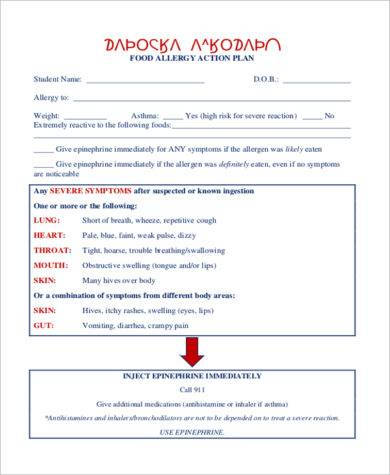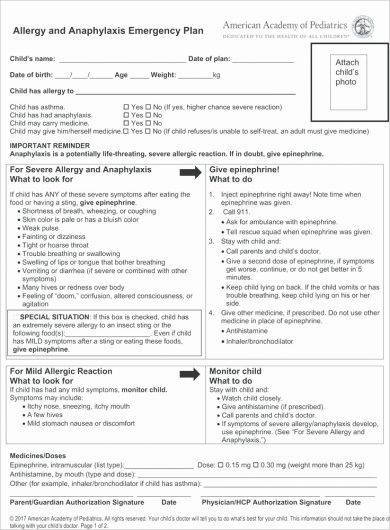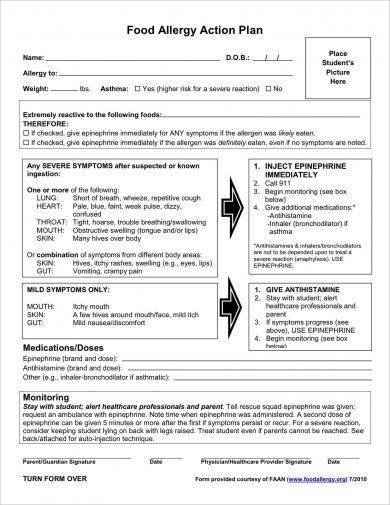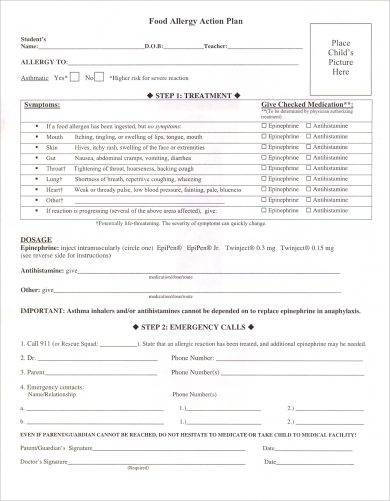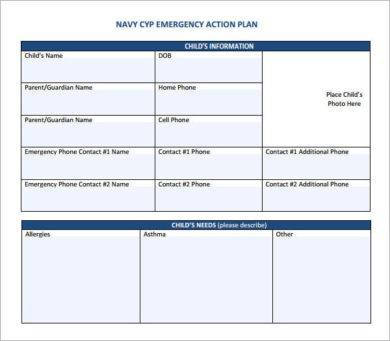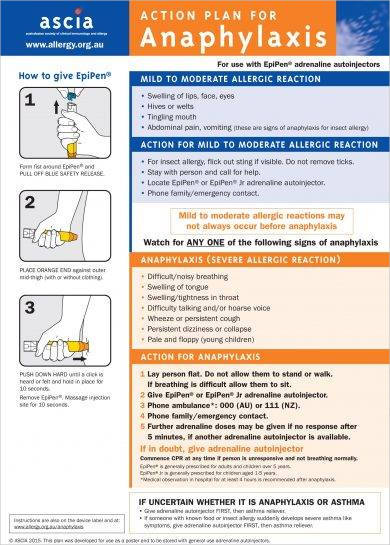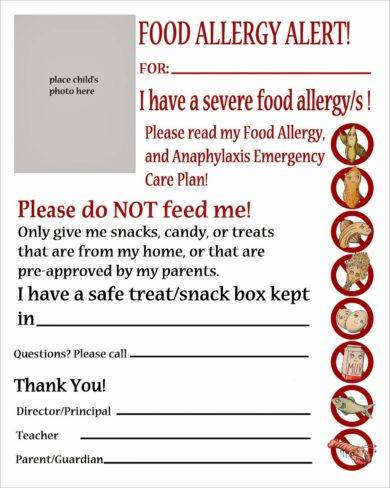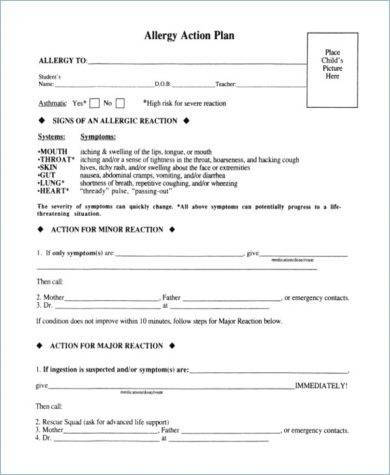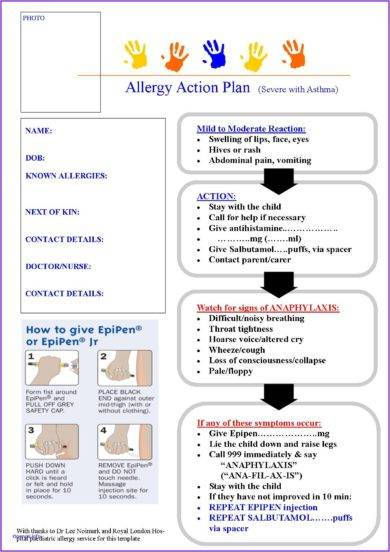9+ Allergy Action Plan Examples to Download
Living with allergies of any kind simply sucks. There’s no better way of saying it, and no amount of flowery words can disguise the fact that being vulnerable to one of the most common allergies can limit our way of “living life to the fullest.” You may also see what is an action plan.
Unfortunately, some allergic reactions that an average person experiences can be life-threatening as well, causing some victims to fight for their lives as people around them rush to call 911. Others, however, may not be that serious, but still need to be treated accordingly before it gets any worse. This is one of the reasons why having a clear action plan in place is extremely helpful. It’s a crucial document that parents, teachers, and colleagues can refer to whenever there is an emergency.
Student Allergy Action Plan Example
Allergy Emergency Action Plan Example
Food Allergy Action Plan Example
Five of the Most Common Allergies
Millions of people from around the globe suffer from different types of allergies. It’s a disorder that starts with one fateful mistake: your immune system misjudging some harmless substance that you’ve ingested by interpreting it as a dangerous pathogen. You may also see business action plan examples.
So every time your system detects particles of this offending substance (allergen), it triggers a series of side effects, such as itching, swelling, sneezing, or wheezing. In a few cases, the allergy can also cause anaphylaxis, which is a severe, potentially life-threatening allergic reaction that can occur within minutes or even seconds of exposure to something the victim is allergic to. You may also like employee action plan examples.
People can be allergic to basically anything. For instance, any food can cause an allergy, though we may not feel the symptoms the first time around, they tend to come out when we least expect them to. Most allergic reactions to food among children are caused by milk, peanuts, soybean, eggs, wheat, and tree nuts. Adults, on the other hand, typically react to citrus fruits, peanuts, shellfish, and wheat. You may also check out sales action plan examples.
Here are some examples of common allergies:
1. Milk
As much as we enjoy having milk along with our breakfast cereal, allergy to cow’s milk is a pretty common food allergy among children. A reaction is either triggered by small amounts of cow’s milk consumed by the child directly, or through the mother’s breast milk from a variety of dairy products (milk, butter, cheese, ice cream, etc.) she has eaten. You might be interested in marketing action plan examples.
Although some children eventually grow out of this food allergy, about one-fifth of them will carry this allergy even as adults. Fortunately, the symptoms caused by a milk allergy are often mild. This includes rashes, diarrhea, vomiting, and stomach cramps. You may also see SMART action plan examples.
2. Nuts
If you were allergic to nuts as a child, it’s likely that this food allergy will be carried on as an adult. Walnuts, hazelnuts, pecans, almonds, pine nuts, Brazil nuts, cashew nuts, and macadamia nuts are likely to cause allergic reactions among those who consume them. You may also like career action plan examples.
On rare occasions, these nuts may also cause anaphylaxis to those who are sensitive. This is why people with nut allergies are urged to seek advice from their doctors.
3. Shellfish
It must be hard to be allergic to shellfish, especially when you live in a tropical location that’s famous for its fresh catches.
Sadly for some, allergy to shellfish is quite common. People who are sensitive may react to shrimp, lobster, crab, oysters, crayfish, mussels, scallops, and clams. If you’re allergic to one type of shellfish, it’s highly possible that you could react to the other types. Some people are so sensitive that their bodies even react to the vapors from cooking these dishes. You may also see team action plan examples.
4. Dust Mites
Dust mites are minute, eight-legged creatures that thrive in warm, humid places. They are so small that you can find hundreds of them living in a single gram of dust.
Their favorite hideouts include, rugs, carpets, bedding, clothes, stuffed toys, and even in the fur of your pets. They can be malicious when trapped inside a closed-up house, which explains why you can’t help but sneeze whenever you enter an old house that hasn’t been cleaned for quite a while. People who come in contact with these intruders may experience itching and sneezing throughout the day. You may also like corrective action plan examples.
5. Pollen
Trees are known for producing pollen, which is the dust-like, male reproductive part of plants that causes allergy among children and adults. You might recognize pollen allergy as “seasonal allergic rhinitis” or “hay fever.” People who breathe in pollen-heavy air may experience sneezing, nasal congestion, runny nose, watery eyes, wheezing, and even an itchy throat and eyes. You may also check out 90-day action plan examples.
Since you can’t really argue with Mother Nature, the best way to avoid this is to wear a mask throughout the first quarter of the year, wash your hair at night, keep your nose clean, or simply take an antihistamine whenever you need to.
Food Allergy Action Plan Sample
Simple Allergy Action Plan Example
Allergy Action Plan for Anaphylaxis Example
Allergy Action Plan for Children Example
How to Treat Allergies
Suffering from certain types of allergies can be a huge pain. They can interfere with your quality of life, and if severe conditions are not treated correctly, they can be fatal.
Generally, allergy treatments may vary, depending on your condition and the type of allergy you have. It’s important to see a doctor to gain access to a wide range of prescription options to treat your condition. But if your allergies aren’t severe and are merely annoying, there are many over-the-counter treatments that a pharmacist can recommend based on your symptoms. You may also see how to make an action plan.
The commonly used remedies for certain allergy-related symptoms include nasal sprays and allergy drugs.
Decongestant sprays are often used to temporarily relieve sinus-related symptoms such as runny nose, watery eyes, sneezing, and nasal congestion. Some over-the-counter and prescription examples include steroid sprays, antihistamine sprays, and saline nasal sprays. You may also like strategic action plan examples.
Besides nasal sprays, there are some medications that can help reduce the human body’s reaction to these allergens. These drugs can be taken as liquids (syrups) or pills.
Common allergy medicines include antihistamines, decongestants, mast cell stabilizers, steroids, leukotriene modifiers, and epinephrine. Take note that you may experience several side effects after taking these drugs, such as drowsiness, dizziness, increased appetite and weight gain, upset stomach, and thickening of mucus caused by antihistamines. You may also check out personal plan examples.
Developing a Food Allergy Policy for Children
Food allergy among children can be quite dangerous, especially when a child is unaware about how to react whenever faced with the condition. The key to preventing potentially severe reactions is to avoid the child from being exposed to the relevant allergen. Though parents can easily keep a child away from these allergens, an accidental exposure is still possible in public grounds. You may also see budget action plan examples.
It’s important for schools and learning centers to develop and implement an allergy policy for children. With the number of students that come in contact with one another each day, the risk of allergen exposure is relatively high. While it may be difficult for the school to avoid common allergens brought by the environment, the least they can do is to create a food allergy policy for their pupils. You may also like sales action plan examples.
1. No sharing of food, utensils, and containers.
Sharing of food, containers, and utensils should be prohibited. Apart from avoiding allergen exposure, this should also be implemented for sanitary reasons as well.
2. Label bottles and other containers with the owner’s name.
Lunchboxes, bottles, and utensils brought from home should be labeled accordingly. This will prevent any possible mix-ups that may cause an accidental exposure. You may also see corrective action plan examples.
3. Clean containers and utensils thoroughly.
Clean eating areas and wash containers and utensils thoroughly with warm soapy water. You can also use a dishwasher to remove traces of potential allergens.
4. Wash your hands.
Encourage children and staff members to wash their hands before and after meals. Besides allergens, some pupils may be carrying contagious diseases that may be transmitted through personal contact.
5. Have food and drinks checked by parents.
For severely allergic children, it might be necessary for parents to check the food and drinks that their children consume. School cafeterias may be carrying food that their children are allergic to, so they may want to inform the school beforehand. If possible, parents may provide their children with packed meals prepared at home. You may also like employee corrective action plan examples.
6. Follow recommendations made by a medical specialist.
Ongoing training and education for teachers and staff members about food allergy management should be practiced. Though most institutions have a school nurse to address the situation, educators should still be made aware of the necessary protocol in the event of an emergency. You may also check out risk plan examples.
Allergy Action Plan for Emergencies Example
Allergy Action Plan Template
Allergy Action Plan with Asthma Example
How to Make an Allergy Action Plan
Having a life-threatening allergy can be very stressful. Starting school, changing jobs, joining extracurricular activities, and enrolling in a summer camp can be pretty risky for someone who’s vulnerable to a specific allergen that’s pretty common in our surroundings. To ensure that you or your loved one stays safe, having a good allergy action plan will definitely come in handy.
An allergy action plan is a document that can help educators, administrators, coworkers, and other staff members know how to respond if a reaction occurs. This will also help those who are unaware of the common allergies decipher symptoms and react quickly in case of an emergency. You may also see teacher action plan examples.
Here’s how you can make an effective action plan:
1. Take a photo.
Include a picture of the individual in the document. There’s a chance that the individual may be in the care of a substitute or someone who may not be familiar with the individual or the condition. This will let everyone know who is being referred to in the document. You may also like performance improvement plan examples.
2. Create an emergency contact list.
This is a critical part of the document that should never be overlooked. It’s important to pick emergency contacts who are familiar with the allergies, the medications, and how to administer them. This includes parents, legal guardians, and the individual’s personal physician. You may also check out development plan examples.
3. Provide a medication list.
Before listing the necessary medications and how they should be administered, be sure to check with your doctor first. Any questions or concerns must be addressed prior to completing the action plan.
Simple action plans can be incredibly useful in times of emergency. But ultimately, the best way to manage these allergies prior to taking any medication is to avoid the potential triggers in the first place. If strange symptoms begin to act up, you can do your research or consult your doctor before it goes out of hand. Though unknown allergies can’t always be avoided, you can reduce the risk of exposure to hidden allergens by eating fewer processed foods and living a sanitary lifestyle.



